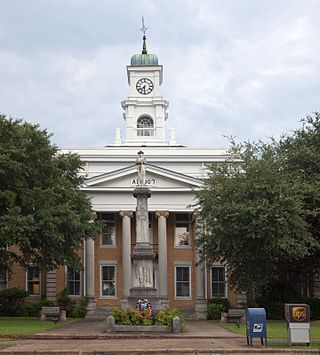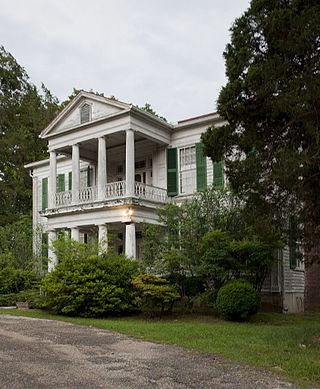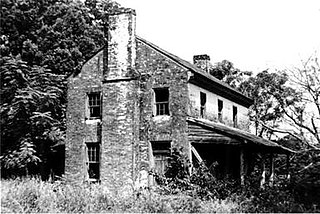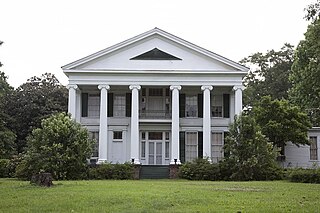
Hale County is a county located in the west central portion of the U.S. state of Alabama. As of the 2020 census, the population was 14,785. Its county seat is Greensboro. It is named in honor of Confederate officer Stephen Fowler Hale.

Greensboro is a city in Hale County, Alabama, United States. At the 2010 census the population was 2,497, down from 2,731 at the 2000 census. The city is the county seat of Hale County, Alabama, which was not organized until 1867. It is part of the Tuscaloosa, Alabama Metropolitan Statistical Area.

Newbern is a town in Hale County, Alabama, United States. As of the 2020 census, the population of the town was 133.
Samuel "Sambo" Mockbee was an American architect and a co-founder of the Auburn University Rural Studio program in Hale County, Alabama. After establishing a regular architectural practice in his native Mississippi, Mockbee became interested in the design and construction problems associated with rural housing in Alabama and Mississippi. Soon after joining the faculty of Auburn, Mockbee established the Rural Studio with educator Dennis K. Ruth to provide practical training for architecture students in an environment where their efforts could address the problems of poverty and substandard housing in underserved areas of the southern United States. Mockbee went on to receive numerous awards for his work, including a MacArthur Foundation grant that he used to further the work of the Rural Studio.

Studio 804 is a graduate level architecture design studio developed by Professor Dan Rockhill at the University of Kansas. The course is distinguished from typical architecture studios in that it is a design-build studio in which the students work collaboratively to not only design a project but to actually construct it. Studio 804 is a two-semester, 9 month commitment. During the first semester students work collectively to determine a client for the next project. Once a client is established, students usually have 2 months to design the project beginning with the Schematic Design phase and seeing it through to Construction Documents. The second semester usually begins in early January to start off the building process. One home is built by Studio 804 annually.

St. Andrew's Episcopal Church, also known as St. Andrew's Church is a historic church building on County Highway 12 in Prairieville, Alabama. Built by slaves in 1853, it is a remarkably well-preserved example of Carpenter Gothic architecture, its design apparently taken from a book by Richard Upjohn. St. Andrew's was added to the National Register of Historic Places on November 7, 1973, and was declared a National Historic Landmark on the same day. Public access is allowed to this National Historic Landmark.

St. Luke's Episcopal Church is a historic Carpenter Gothic church, built during the 1850s at Cahaba, the first capital of Alabama from 1820 to 1826. The unknown builder closely followed plans published by architect Richard Upjohn in his 1852 book Rural Architecture.

Design Build Bluff is a program of The University of Utah's College of Architecture + Planning, where each year, architecture graduate students are immersed in a hands-on opportunity to design and build a full-scale work of architecture in collaboration with the Navajo people. The program derives its name from the town of Bluff, Utah, adjacent to the Navajo Nation, in which the campus facility is located. Design Build Bluff projects are a full donation to the client and are noted for being innovative, sustainable and award-winning designs. The program is currently collaborating with the Mexican Water Chapter House on more community based projects.

Tanglewood is a historic plantation house in Akron, Alabama. The Greek Revival cottage was built in 1859 by Page Harris, on land that he had purchased in 1824. It was given to the University of Alabama as a memorial to Nicholene Bishop in 1949 and the grounds are now used as a 480-acre (190 ha) nature reserve known as the J. Nicholene Bishop Biological Station. It is used by the university to aid undergraduate and graduate research in biodiversity and environmental processes. The house was added to the National Register of Historic Places on April 11, 1973, due to its architectural significance.

Glencairn, also known as the John Erwin House, is a historic house in Greensboro, Alabama, United States. The house and grounds were recorded by the Historic American Buildings Survey in 1935. The house was added to the National Register of Historic Places on January 18, 1978, due to its architectural and historical significance.
The Greensboro Historic District is a historic district in the city of Greensboro, Alabama. Greensboro was incorporated as a town in December 1823 as Greensborough. The community was known as Troy prior to that time. The historic district is centered on Main Street and runs from Hobson Street on the western side of the city to 1st Street on the eastern side. It features examples of Federal, Greek Revival, and regional vernacular architecture. One significant contributing property is Magnolia Hall. It was placed on the National Register of Historic Places on August 13, 1976.

The McGehee–Stringfellow House, also known as Oak Grove, was a historic plantation house near Greensboro, Alabama, United States. It was added to the National Register of Historic Places on September 17, 1980, due to its architectural significance. It was accidentally destroyed in the 1980s during an attempt to move it to another location.

Elm Ridge Plantation, also known as the Hatch House and Holbrook House, is a historic forced-labor farm and plantation house in rural Hale County near Greensboro, Alabama. The one-story raised cottage-style house was built about 1836. It was added to the Alabama Register of Landmarks and Heritage on November 2, 1990, and to the National Register of Historic Places on October 11, 1991, due to its architectural significance.
Coleman Coker is an American architect and educator. He is the first Professor of Practice at the University of Texas at Austin School of Architecture and the Director of the Gulf Coast DesignLab which he began in 2012.
Sawyerville, previously known as Sawyers Depot, is an unincorporated community in west-central Hale County, Alabama and is a part of the Tuscaloosa metropolitan area. It derives its name from the town's first post master. The community is rural and came to flourish due to its proximity to the railroad that once traveled through it. The community covers the historic area of the county once called Hollow Square and includes the abandoned town site of Erie, the former county seat of Greene County. It also includes the communities of Wedgeworth, Melton, Warrior Dam, and Mason Bend. The area was the site of several Pickens family plantations, most notably those of early Alabama governor, Israel Pickens, and his younger brother, Samuel Pickens. The Samuel Pickens homestead, Umbria Plantation, was destroyed by fire in 1971.

Magnolia Hall, also known as the McCrary-Otts House, is a historic Greek Revival mansion in Greensboro, Alabama. It is a contributing property to the Greensboro Historic District, listed on the National Register of Historic Places, and was individually listed on the National Register in 2021. It was recorded by the Historic American Buildings Survey in late March 1936.
Public interest design is a human-centered and participatory design practice that places emphasis on the “triple bottom line” of sustainable design that includes ecological, economic, and social issues and on designing products, structures, and systems that address issues such as economic development and the preservation of the environment. Projects incorporating public interest design focus on the general good of the local citizens with a fundamentally collaborative perspective.
Wells Mason is an American designer and sculptor.

The Helton Cottage is an early 19th century dwelling located in Greensboro, Alabama. The house is one story with a modified pitched roof and circa 1840s lattice porch. The house began as a single room, possibly an outbuilding of the nearby Johnston-Torbet House. The house was on a parcel belonging to Thomas Johnston in the 1830s. The property was subdivided and given to his daughter Caroline and her husband Dr. William Jones. The Jones's children sold the house to Caleb Jones, a British immigrant who ran a jewelry store and was an amateur astronomer. In 1905, the house was purchased by Mr. and Mrs. John Helton. Their tenure in the house led the community to call the house by its current name.













